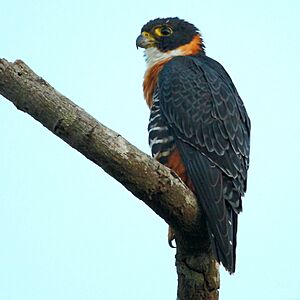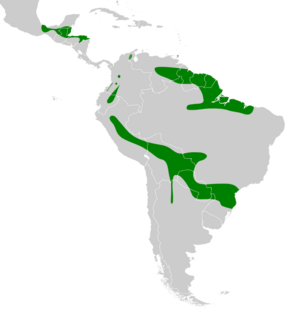Orange-breasted falcon facts for kids
Quick facts for kids Orange-breasted falcon |
|
|---|---|
 |
|
| at Chapada dos Guimarães, Mato Grosso State, Brazil | |
| Conservation status | |
| Scientific classification | |
| Genus: |
Falco
|
| Species: |
deiroleucus
|
 |
|
The orange-breasted falcon (Falco deiroleucus) is a powerful bird of prey from the falcon family. It's considered Near Threatened, which means its numbers are getting low. You can find this amazing bird in southern Mexico, Belize, Guatemala, and Panama. It also lives in many countries in South America, though it's not found in Chile or Uruguay.
Contents
About This Falcon's Family
Scientists group animals based on how they are related. This is called taxonomy. The orange-breasted falcon is closely related to the bat falcon and the aplomado falcon. They share similar looks and sounds.
The orange-breasted falcon is also "monotypic." This means it's the only type of orange-breasted falcon. It doesn't have different subspecies or varieties.
What Does the Orange-Breasted Falcon Look Like?
Male orange-breasted falcons are about 35 to 36 cm (14 inches) long. They weigh between 325 and 425 grams (11 to 15 ounces). Females are larger, measuring 38 to 40 cm (15 to 16 inches) long. They weigh more too, from 550 to 700 grams (19 to 25 ounces). This species has the biggest size difference between males and females of all falcons!
These falcons are strong birds with large heads. Both males and females look similar. They have a black head and bluish-black feathers on their upper body. Their throat and the sides of their neck are white. Their upper chest is a pretty orange color, which gives them their name. Below that, their chest is black with reddish-brown stripes. Their belly and legs are the same orange color as their upper chest.
The skin around their eyes, called the cere, and their legs and feet are usually bright yellow. Young falcons are paler and less colorful than adults. Their bare parts are dull bluish-green at first, becoming more yellow as they grow up.
Where Does the Orange-Breasted Falcon Live?
The orange-breasted falcon used to live in a much larger area, from southern Mexico all the way to northern Argentina. Sadly, their home range has shrunk a lot. Today, they are mostly seen in Belize, Guatemala, and Panama in Central America. They might still be in southern Mexico, but they are very rare or gone from Costa Rica, Nicaragua, and Honduras.
In South America, they are rare but present in Brazil, Ecuador, Peru, and Venezuela. Scientists are still trying to figure out their exact numbers in other countries like Bolivia, Colombia, and Guyana. Because they look a lot like the more common bat falcon, it can be hard to know exactly where they are.
These falcons need tropical rainforests and forests with cliffs to build their nests. They prefer old, untouched forests, but they can also live in areas with a mix of forest and open spaces.
Who Hunts the Orange-Breasted Falcon?
Some animals hunt the orange-breasted falcon. These are called predators. Black-and-white hawk-eagles and stygian owls are known to hunt these falcons in Belize.
Black vultures, which are common in Central and South America, don't hunt the falcons directly. However, they can take over the falcon's nesting spots on cliffs. This makes it harder for the falcons to successfully raise their young.
Africanized bees also like to build nests on the same cliffs as the falcons. While there's no direct proof they harm the falcons, these bees are known to bother other bird species. There was even a rare sighting of a vampire bat feeding on a female falcon while she was sitting on her eggs!
Falcon Behavior
Movement
Orange-breasted falcon pairs usually stay in the same territory all year long. Young falcons leave their parents when they are old enough to be on their own, but we don't know how far they usually travel.
Feeding Habits
The orange-breasted falcon eats many different kinds of birds and also bats. In Belize and Guatemala, scientists have seen them eat 45 different bird species! They hunt above the forest trees, diving down from a cliff or a tall dead tree. They can also swoop down from very high in the sky. Sometimes, they use a clever trick to catch migrating birds and bats: they fly against the sky at dawn or dusk, making their prey stand out as a silhouette.
Reproduction and Life Cycle
Orange-breasted falcons usually make their nests in a small dip or hole on a cliff ledge. Sometimes, they've even nested on ancient temples, like in Guatemala's Tikal National Park. A few times, they've nested in tree branches.
A female falcon usually lays three eggs, but sometimes it can be two or four. The eggs hatch after about 30 to 34 days. The young falcons are ready to fly about 40 to 45 days after they hatch. The female falcon does most of the egg incubation and feeding of the baby birds. We don't know exactly how long it takes for the young falcons to become fully independent after they learn to fly.
Bathing
One interesting observation is that an orange-breasted falcon was seen purposely crashing into tree leaves that had water collected on them. It seemed like it was taking a bath!
Vocalization
Both male and female orange-breasted falcons make a lot of noise when they are breeding. Their aggressive defense call is a fast "key-key-key-key" sound, repeated until whatever is bothering them goes away. This call has also been described as "kyowh-kyowh-kyowh." When pairs are courting, they make soft chirps or piping sounds.
Status and Conservation
The IUCN has listed the orange-breasted falcon as "Near Threatened." This means that while it lives in a big area, there aren't many of them, and their numbers are believed to be going down.
The biggest threat to these falcons is the clearing of forests for wood, farms, and ranches. Also, black vultures and Africanized bees might be affecting their nesting success, as mentioned earlier.
Good news! The Peregrine Fund is working to help these falcons. They raise orange-breasted falcons in captivity. Since 2007, they have released 56 falcons into the wild in Belize. By 2013, 23 of these birds had become independent, and some even paired up with wild falcons and started breeding!
Images for kids



